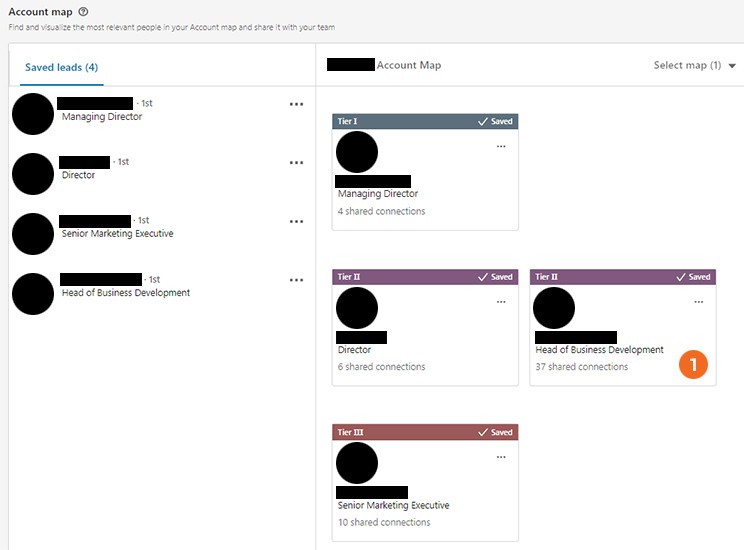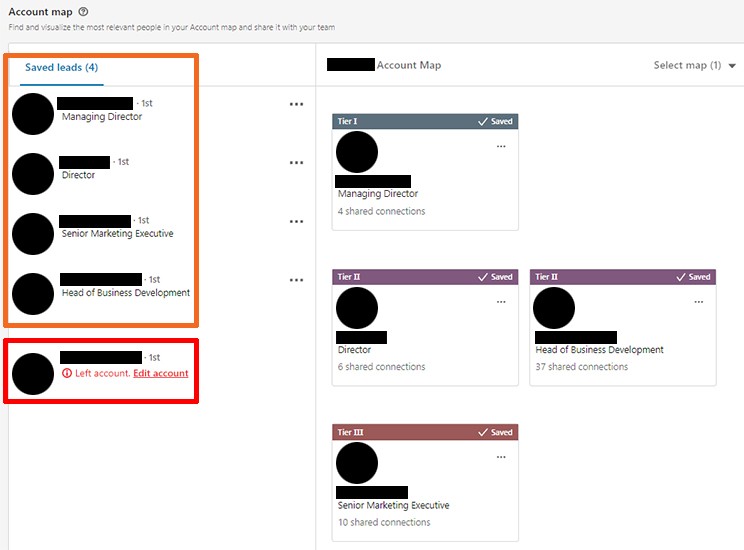
When marketing yourself on LinkedIn and looking to build relationships and generate leads, it’s important to follow a structured approach. This is especially true when your ideal clients are medium to large companies because there are so many different levels of people who will have an influence on the buying decision.
On average there are 6.8 decision-makers involved in every large purchase. In smaller purchases and in smaller companies this will be less, but it will be more than you think. This means that in every buying decision, there is not just one person influencing the purchasing decision.
To help with this process on LinkedIn, there is a piece of functionality in Sales Navigator called the Account map. This is designed to help you to visualise and identify this buying team and arrange them in Tiers on the Account page. It helps you to identify and organise the key players and identify any potential gaps.
In order to give you a further understanding of how this can be used in practice, I will take you through my sales and marketing journey with a new client. Names have been blacked out to protect the innocent!
1. Lead Generation

Whom I Target
I help sales teams (and individuals) to build robust sales pipelines. The individual within medium to larger-sized companies that cares the most about generating sales, because they are personally responsible for this, is the Head of Business Development (or some other similar title).
They may not be the person that signs off on my proposal, but they will certainly have a vested interest in bringing in new business because it’s their responsibility and their job may depend on this.
Lead Generation
In my example, I reached out to the Head of Business Development with a connection message and he joined my network. I followed up with a welcome message to which he replied. We chatted a little and agreed to arrange a call as he liked my relaxed approach. When promoting yourself on LinkedIn you should not be selling.
Account Map
At this point, I added the Head of Business Development to my account map for the company at Tier 2 (see the circle with 1 above).
2. Sales Process

Meeting 1
Before the sales call, I did some research so that I was ‘ready’ for the call. On the call, we clicked instantly and there appeared to be a good fit with what they needed help with and what I’m able to help with.
So, we decided to take it to the next step, which was to arrange a meeting with his colleagues. I asked who was going to be involved and I was told it would be a contact from marketing, a director of the company and the managing director. This was good to hear because the meeting involved the decision-maker.
Account Map
At this point, I added all three of them to the account map at Tier 1, 2 & 3 (see the circles with 2 above).
Meeting 2
On the second call, there were only four of us in the meeting. The managing director couldn’t make it. During the meeting, we talked in more detail about what they were doing, the help they required, and I took them through what I could help with and of course, provided ‘evidence’ of delivering for clients. The meeting went well so the next step was to create a proposal for the first piece of work.
Connection Requests
Immediately after the meeting, I sent connection messages to both the marketing contact and the director as we had just met on a Zoom call.
Proposal
As per the meeting and the agreed scope of work, I put together a proposal and sent it on to all three who attended the meeting but also copied in the managing director to keep him in the loop. He was invited to the second meeting so I had been given his email. The proposal was duly accepted.
Connection Request
On accepting the proposal, I sent a connection message to the managing director saying I was looking forward to working with them and helping them. He duly accepted and we had a short conversation.
The sales process is your opportunity to network and develop those relationships at all levels. The more relationships you develop the stronger your position is within the company immediately and long term.
3. After Sales

Getting a sale is only the start of your relationship with your new client. When delivering your service, you will develop the relationship even further and will hopefully develop a really strong rapport with your clients.
Develop The Relationship
As you can see above in the account map in the orange box, I have saved my four contacts at the company as leads (this refers to someone I have saved as a lead in Sales Navigator, which could be someone in the sales process or a customer).
When I do this, it triggers alerts in Sales Navigator, which are information notes about the activities my contacts are doing on LinkedIn that I can see in my Home feed.
These alerts tell you whether your lead is publishing content, whether they viewed your profile, appeared in the news, or more importantly for this article, whether they have changed careers. These alerts are prompts for you to take action.
Alert & Account Map Actions
The first three alerts are opportunities to reach out and engage with your client. It’s an opportunity to engage with them to keep the relationship strong, and it may be an opportunity to speak to them about a new offer you have.
The Career Change alert can be viewed as an early warning system, but also an opportunity. In the image above in the red box, I have added a contact who has left. This is how it looks on the account map.
The alerts warning system enables you to know immediately when a contact updates their LinkedIn profile. For the company you work for, it provides a prompt to find out who the new contact is and replace them in the account map and start to build a relationship with them.
For the person that has left, where have they gone? Has someone in a tier 3 position now been promoted to tier 2? If you have kept in touch with them and kept the relationship strong, then the new company they have moved to is an opportunity for a new client. Start building your account map at the new company and as a ‘known’ contact, your chances of securing them as a new client are far more likely than if they were new.
Conclusion
LinkedIn is a great platform for networking and building relationships, but Sales Navigator and Account Maps can help you to organise these relationships for each of the contacts at your existing clients and potential clients.
Many of my clients when I first start working with them aren’t even connected to one contact of their existing client base and I help to guide them through the process to secure those accounts. Much of their focus is on securing new business when I meet them, but my point to them is what are you doing to secure what you have already got?
Over time people will leave. If you don’t add enough points of contact at your client companies as 1st connections, save them as leads, add them to your account maps, and build strong relationships with them, you are leaving yourself exposed to losing existing clients.
Connect with all points of contact in the buying team during the sales process. Replace those that do leave with the new point of contact, and follow up with the person who has left as this may be a new opportunity for a new client.
Don’t leave yourself exposed as it may come back and bite you.



